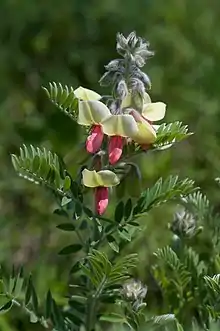| Tephrosia virginiana | |
|---|---|
 | |
| Scientific classification | |
| Kingdom: | Plantae |
| Clade: | Tracheophytes |
| Clade: | Angiosperms |
| Clade: | Eudicots |
| Clade: | Rosids |
| Order: | Fabales |
| Family: | Fabaceae |
| Subfamily: | Faboideae |
| Genus: | Tephrosia |
| Species: | T. virginiana |
| Binomial name | |
| Tephrosia virginiana | |
| Synonyms[1] | |
| |
Tephrosia virginiana, also known as goat-rue, goat's rue,[2] catgut,[2] rabbit pea,[2] Virginia tephrosia,[2] hoary pea,[3] and devil's shoestring[4] is a perennial dicot in family Fabaceae. The plant is native to central and eastern North America.
Description
This subshrub is low and bushy, growing to 60 centimetres (2 ft), but more often shorter. Its leaves are alternate and compound, usually with 8 to 15 pairs of narrow, oblong leaflets.[3] Soft white hairs on the leaves and the stem give them a silvery, or hoary, appearance.[5]
The flowers look similar to other flowers in the pea family and are bi-colored, with a pale yellow or cream upper petal (the standard), and pink petals on the bottom (the keel and wings).[4] The flowers are grouped into clusters at the top of the stems and bloom from May to August. The seed pods that form after the flowers bloom are small, approximately 5 centimetres (2 in) long.[3]
The roots are long and stringy, which is probably the source of the common names catgut and devil's shoestrings.[4]
Distribution and habitat
This plant prefers acidic soils, in part to full sun.[6] It grows throughout the Midwest, New England and southeastern United States.[7] Not easy to propagate because of the relationship it has with the acid soil it needs,[8] this plant can be found in sand savannas, open woods and glades, prairies and rocky soils.[3]
Toxicity
All tissues of this plant are toxic (containing rotenone), and should not be eaten by people or livestock. Crushed stems were previously used as a fish poison.[9]
References
- ↑ "The Plant List: A Working List of All Plant Species". Retrieved 26 July 2014.
- 1 2 3 4 "Tephrosia virginiana". Germplasm Resources Information Network. Agricultural Research Service, United States Department of Agriculture. Retrieved 14 January 2018.
- 1 2 3 4 Denison, Edgar (2017). Missouri Wildflowers (Sixth ed.). Conservation Commission of the State of Missouri. p. 64. ISBN 978-1-887247-59-7.
- 1 2 3 "Lady Bird Johnson Wildflower Center - The University of Texas at Austin". www.wildflower.org.
- ↑ "Tephrosia virginiana (Catgut, Devil's Shoestring, Goat's Rue, Hoary Pea, North American Turkey Pea, Virginia Goat's Rue, Virginia Tephrosia, Wild Sweetpea) | North Carolina Extension Gardener Plant Toolbox". plants.ces.ncsu.edu.
- ↑ "Tephrosia virginiana - Plant Finder". www.missouribotanicalgarden.org.
- ↑ USDA Plants Database
- ↑ "Goat's Rue". www.fs.usda.gov.
- ↑ Zhang, Peiwen; Qin, Deqiang; Chen, Jianjun; Zhang, Zhixiang (21 October 2020). "Plants in the Genus Tephrosia: Valuable Resources for Botanical Insecticides". Insects. 11 (10): 721. doi:10.3390/insects11100721. PMC 7589259. PMID 33096762.
- Peterson, Lee. (1977) A Field Guide to Edible Wild Plants of Eastern and Central North America. Houghton Mifflin Company, Boston. p. 82.
External links
